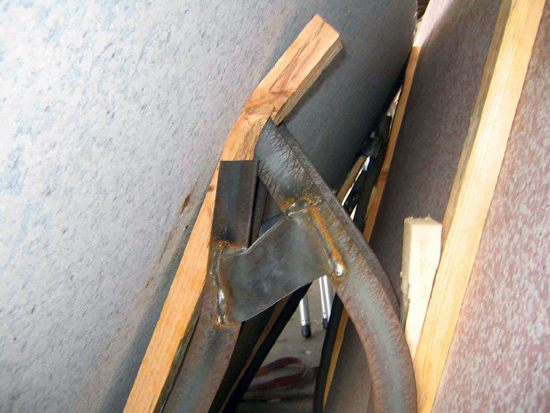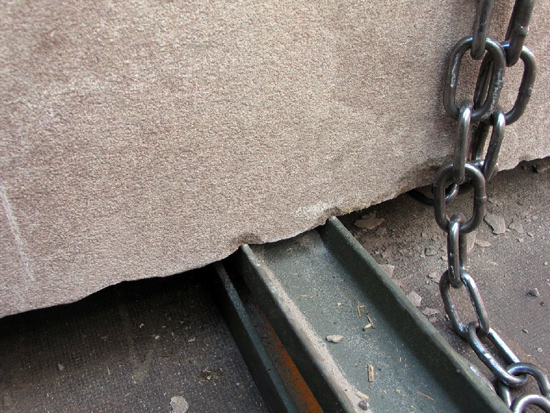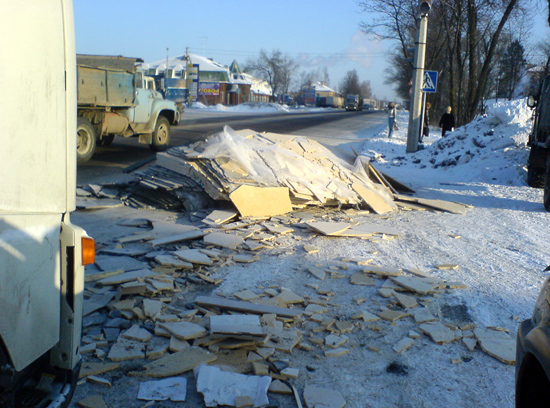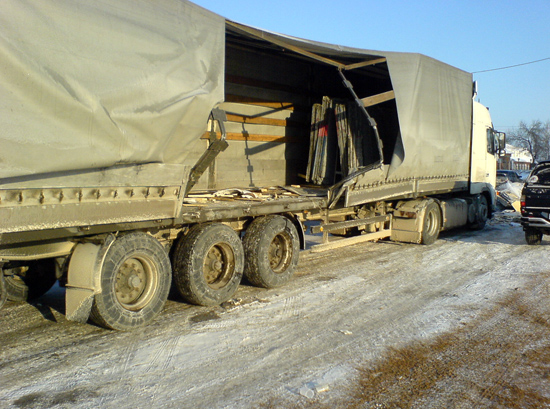| Photo of the month – March 2007 | [German version] |
„Undersize A-frames“
Reliable load securing always starts with packaging and forming the cargo units. As a fundamental principle, a cargo unit must be in a position to withstand any loads that can be expected to arise during transportation. Unless it is intended exclusively for tight-fit loading, a cargo unit must provide possibilities for securing the load. This means that it must be possible to attach and/or secure load securing materials to the cargo unit in such a way that the load can be adequately secured while remaining undamaged. If the load and any loading frames such as A-frames do not form a rigid unit, it may be necessary for both to be secured.

Figure 1 [Captain A. Shmelev]
Figure 1 shows the A-frames already mentioned in the title. Each of these A-frames comprises three H sections:
| one section rests on the floor as a base, | |
| two sections are joined to form an „A“ and are secured to the base and to each other with small metal plates. |
The upper securing plate can be seen clearly in Figure 1. It can also be seen that the A-frames used here did not have stabilizing ties within the „A“, neither are they connected to each other.

Figure 2 [Captain A. Shmelev]
In places, wood was used on the vertical struts that form the „A“ in order to protect the slabs, but this was not done on the base section on which the slabs were placed. The methods used to
| package the stone slabs, | |
| secure the unitized stone slabs on the A-frames, | |
| and to secure these to the trailer are utterly inadequate. |
The main reasons are as follows:
| To start with, the A-frames are far too small. | |
| Secondly, they are woefully inadequate to withstand the loads caused by the weight of the cargo. | |
| Thirdly, no friction-enhancing measures have been taken to protect the cargo on the one hand and to better secure the A-frames on the vehicle. | |
| Fourthly, the A-frames are not connected to each other with the result that the load itself must establish this „connection“. However, the stacked stone slabs are not able to fulfill this function, since they drift and sway to and fro with the unsecured A-frames. | |
| Fifthly, the „cargo unit“ with a weight of something between 5 and 8 tonnes was bundled together using long-link chains and „secured“ using two tie-down lashings. This type of securing can only be interpreted as an act of desperation on the part of the driver and that the consignor was entirely unwilling or unable to fulfill his responsibilities for putting this load onto the roads safely. |

Figure 3 [Captain A. Shmelev]

Figure 4 [Captain A. Shmelev]
Figures 3 and 4 show the potential hazards of such a load. Normal acceleration forces such as those that occur during cornering, avoidance maneuvers and so on were sufficient to have caused the load to be lost. The danger posed to other road users is enormous and it is unavoidable that the stone slabs will be damaged.
So how is it possible to transport loads of this type safely?
| A-frames must be provided that are both in themselves sufficiently stable and are connected to each other. In order to protect the load, they should at least be lined with softwood on the vertical struts that form the „A“ and on the base section. It may even be expedient to use other friction-enhancing materials such as mats designed for heavy cargo. Anti-slip mats should also be placed under the A-frames. Load-securing considerations and stability aspects both mean that it is sensible if the A-frames are higher than the stone slabs themselves. This means that no bending moments arise if the stone slabs are bundled vertically on the A-frames. In addition, this makes it possible to attach securing material to the top of the A-frames as well as to the base in order to secure them directly to the vehicle. | ||
| At least two horizontal and vertical bundles should be used to secure the load to the A-frames. Textile belts are the material of choice here in order to protect the load. | ||
| If the A-frames do not have end plates against which it is possible to load the stone slabs in a tight fit, the „floating load“ should be secured directly with loop lashings and the A-frame itself should also be directly secured with loop lashings. If the friction between the load and the frame is identical with that between the frame and the loading surface, it may not be necessary to secure the frame separately so that the load and frame together can be secured as a single unit. | ||
| Assuming that the A-frame is sufficiently stable and has no end plates, it can be well secured with six to eight loop lashings provided that sufficient friction-enhancing material is used. The loop lashings should be arranged as follows: | ||
| One loop lashing in the direction of travel placed around the slabs. Steps must be taken to ensure that this lashing cannot slip off. | ||
| One loop lashing in the direction of travel placed around the A-frame itself (if possible at the top of the A-frame). If the friction situation allows it, this loop lashing may be omitted as described above. | ||
| The same applies to the loop lashing to the rear, against the direction of travel. | ||
| To loop lashings on each A-frame must be used to ensure that the A-frame remains in position. | ||
| At the same time, the vertical bundles are supported by the loop lashings to the sides. | ||
Only direct, tight-fit load securing such as this means that the stone slabs have a realistic chance of reaching their destination undamaged.
Back to beginning
